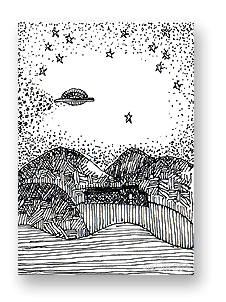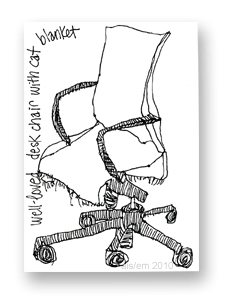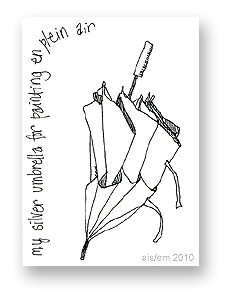I wrote the first draft of this article in 2006, when the arts community was still deciding if we were “art journaling” or creating “artists’ journals.” Then, I expanded the article in 2011, weighing in on the continuing debate. (Today, the phrase “art journaling” seems preferred, so I’ve updated the article… but only a little.)
![]()
Two phrases are often used interchangeably: ‘art journals’ and ‘artists journals.’
For me, an artist’s journal is an illustrated diary or journal representing the artist. It’s about the person’s life, or some aspect of it, such as a travel journal, a diet & fitness journal, or something like my ‘decluttering journal’.
It usually includes art and the journal is also a work of art, in itself.
Many people call that “art journaling,” and I suppose it is. I mean, are we getting tangled in semantics, when the art is what really matters?
So what else is an art journal?
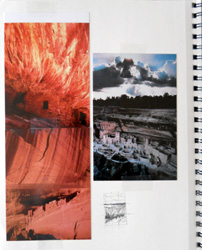 By contrast, an art journal is where I keep notes about art I’m working on or might want to create later. It includes visual inspiration – photos, articles, etc. – as well as my own thumbnail sketches, etc.
By contrast, an art journal is where I keep notes about art I’m working on or might want to create later. It includes visual inspiration – photos, articles, etc. – as well as my own thumbnail sketches, etc.
It’s sort of my pre-art brainstorming, in a journal format.
At left is a page from a 2011 art journal. The photos and sketch represent ideas that I used to inspire an oil painting.
I use an art journal as my on-paper memory of inspiration and original ideas. It’s sort of like a visual thumb drive of art ideas, for later use.
If I don’t jot down my ideas in a journal, they’ll vanish from my thoughts in a matter of days, if not hours. I tend to have a steady stream of creative ideas, and one soon replaces another in my consciousness.
For me, it’s part of the creative process.
Here’s how my ideas develop, through my art journaling
People often ask me where I get my original art ideas. Well, I’m not sure that they’re entirely “original,” but they are fresh and new, if only to me.
Here’s a typical sequence: I started by surfing the Internet to see what other artists are currently working on.
Yesterday, I viewed a website called The Starving Artist’s Way, which included a project using second-hand woolen sweaters that had been washed and dried to shrink them in a “felted” style.
I didn’t think much more about that – not on a conscious level, anyway – but later in the day, after a nap, I woke up thinking about what else I could do with that kind of wool.
While the thoughts were still fresh in my mind -and evolving – I jotted them down in my art journal. These are my two pages of notes:
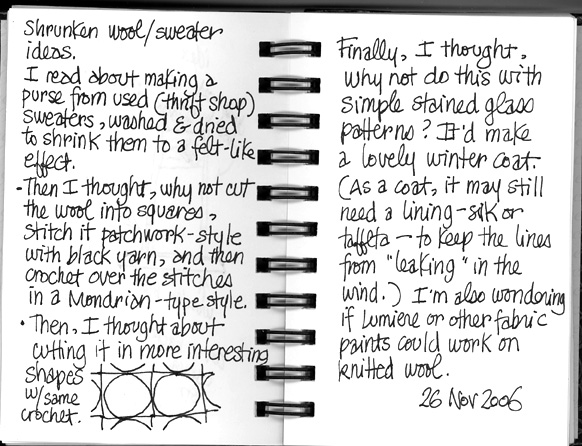
In a nutshell, I was thinking about the kinds of wearable art that I could make with felted-style wool.
(Geek note: It’s not actually “felted” wool when you wash & dry woven/knitted/etc. wool to shrink it. It’s called “fulled” wool. Felting is when you use the raw fibers and a tool to tangle and/or compact them.)
This merged with the Mondrian art that I was reminded of when I was playing an online game, Kingdom of Loathing, yesterday.
And, once I started jotting down these ideas, I remembered when I used to make stained glass windows. Those patterns would adapt nicely to this kind of wool treatment, too.
I’m not sure that I’ll ever actually do anything with this idea. I get a bazillion of these ideas, steadily.
So, I’m scanning the pages from my idea journal, and putting them into my next art zine. I’m doing that for two reasons.
First, it documents that it was my idea. It drives me crazy when I decide to run with an idea and it turns out that another artist has been working on a similar concept… and people think that one of us is “copying” the other, when we’re not.
Second – and more importantly – I am sharing this idea so that someone else might be inspired by it and adapt the concepts (or copy it line-for-line, for all I know/care) to his or her own art.
Sharing art journaling, and the “copying” issue
- My grandfather was a successful inventor and used his ideas to create his own (large) company.
- When his original ideas were copied, he used to chuckle and say, “Plenty more where that came from.”
- In other words, he didn’t complain about those who copied him.
- I’ve always liked that, and he was the richest man I knew, when I was growing up. He literally made millions (when that was a lot of money) from his creative ideas; he was a good role model.
So, I’m okay with the idea of sharing my art journal pages so that people see what one can look like.
However, these may be my own definitions. How you use the terms ‘art journals’ and ‘artists journals’ may be different… and that’s fine with me.
The creativity that matters more than the words!

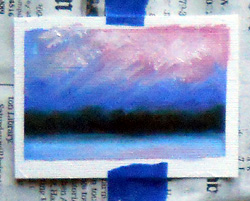 I’m trying some oil paintings as ACEOs. (That stands for Art Card limited Editions and Originals, a kind of artists’ trading cards.)
I’m trying some oil paintings as ACEOs. (That stands for Art Card limited Editions and Originals, a kind of artists’ trading cards.)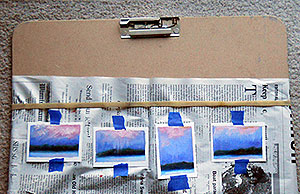 And then, of course, I painted them… at least with an underpainting (my signature cadmium red) and then the first layer of oil paint.
And then, of course, I painted them… at least with an underpainting (my signature cadmium red) and then the first layer of oil paint.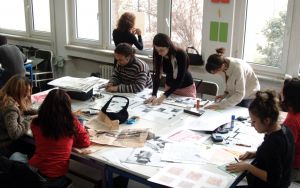 Why art? Really, why would anyone take the time to create art, unless he or she is a full-time artist?
Why art? Really, why would anyone take the time to create art, unless he or she is a full-time artist?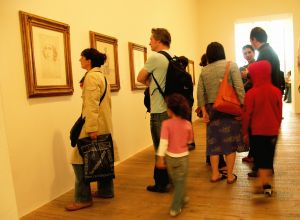 What makes art important in our lives is how art makes us feel.
What makes art important in our lives is how art makes us feel. Aim for something original. That won’t come from copying others, or measuring your work against theirs. The finished product may be a disappointment, but the more important question is: How did you feel when the work came alive? Did you forget about time and tidiness? Did you feel in flow, following a joyful current?
Aim for something original. That won’t come from copying others, or measuring your work against theirs. The finished product may be a disappointment, but the more important question is: How did you feel when the work came alive? Did you forget about time and tidiness? Did you feel in flow, following a joyful current?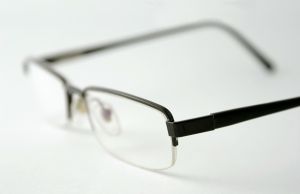 Are you a professional artist, or launching an art career?
Are you a professional artist, or launching an art career?